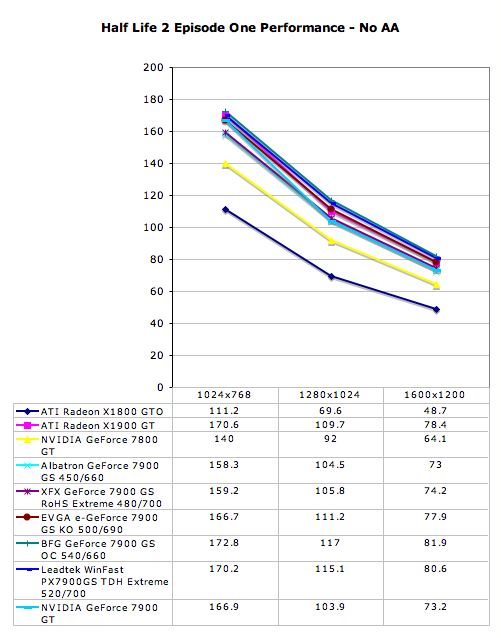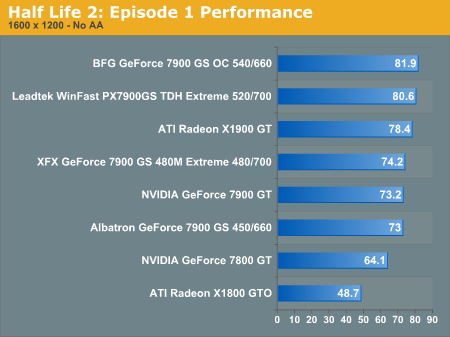The NVIDIA GeForce 7900 GS: A Closer Look
by Josh Venning on September 19, 2006 5:00 AM EST- Posted in
- GPUs
Half-Life 2: Episode One
Half-Life 2: Episode One is another standard game benchmark we use to test our GPUs. The engine has been around for a while, but Valve has been adding things like bloom and HDR effects to give the graphics new life. One thing we like about HL2:E1 is that it gets very good framerates across a wide range of cards, which isn't very common among games of this caliber. For testing we set the detail settings to "high" in the graphics settings for this game. Water detail is set to "Reflect All," and High Dynamic Range is set to "Full (if available)."


Here we again see a significant increase in performance between the Albatron 7900 GS and the BFG and Leadtek cards. We can also compare the performance of the X1900 GT and the different 7900 GS cards and see again how the two fastest 7900 GS cards perform slightly better than the X1900 GT. We can also see that there isn't much difference in performance at all between the 7900 GT and the reference clocked Albatron 7900 GS, which is further evidence that the 7900 GS could be considered the better value card of the two, depending on price.
Half-Life 2: Episode One is another standard game benchmark we use to test our GPUs. The engine has been around for a while, but Valve has been adding things like bloom and HDR effects to give the graphics new life. One thing we like about HL2:E1 is that it gets very good framerates across a wide range of cards, which isn't very common among games of this caliber. For testing we set the detail settings to "high" in the graphics settings for this game. Water detail is set to "Reflect All," and High Dynamic Range is set to "Full (if available)."


Here we again see a significant increase in performance between the Albatron 7900 GS and the BFG and Leadtek cards. We can also compare the performance of the X1900 GT and the different 7900 GS cards and see again how the two fastest 7900 GS cards perform slightly better than the X1900 GT. We can also see that there isn't much difference in performance at all between the 7900 GT and the reference clocked Albatron 7900 GS, which is further evidence that the 7900 GS could be considered the better value card of the two, depending on price.










42 Comments
View All Comments
sum1 - Friday, September 22, 2006 - link
It’s listed at 540MHz everywhere else in this article (including the benchmarks).I posted this discrepancy twice, days ago, hasn’t anyone else noticed yet?
Josh Venning - Saturday, September 23, 2006 - link
It's been fixed. Thanks for pointing this out, and we apologize for not fixing it sooner.PerfectCr - Thursday, September 21, 2006 - link
Fan Noise? How do I know how loud/quiet the fans are? Do they throttle?kmmatney - Tuesday, September 19, 2006 - link
Its interesting how the XFX card (the only RoHS card - uses less lead and other hazardous chemicals) uses more power. I wonder if this will be true of other RoHS devices.yyrkoon - Wednesday, September 20, 2006 - link
I can tell you that the motherbord I use, which is also RoHS 'certified' (Asrock AM2NF4G-SATA2) runs pretty dahmed cool (sub 95F, when ambient is 80F ish), doesnt even use active cooling for the chipset etc either. Reguardless, if its the actual cause or not, I think its well worth it in the long run.Zaitsev - Tuesday, September 19, 2006 - link
On page 3 third line, "NVIDIDA intends for it to be a direct competitor to ATI's X1900 GT"Zaitsev - Tuesday, September 19, 2006 - link
Sorry, that should be page 2.Josh Venning - Tuesday, September 19, 2006 - link
fixed, thanksHoward - Tuesday, September 19, 2006 - link
I believe the bar is there to reduce PCB bending under weight.DerekWilson - Tuesday, September 19, 2006 - link
It's possible I suppose ... but it seems to me that you'd want to attatch the bar to the pcb at more than two points if this is the case. And you might also want to connect it to the slot cover for the added support of the case screw. Granted, I'm not a mechanical engineer, but it seems to me that connecting one part of the pcb to another like this would just move any moment created by the weight of the HSF somewhere else on the pcb.I've also never seen a graphics board bend under normal use. Intel motherboards are another story though. :-)
Whether or not its made for this, I do have a good use for it: having this bar makes it easier to find a place to grab when removing the card. Sometimes it's tough to find a spot on the pcb to grab, and sometimes the HSF solution isn't mounted in such a way that it's stable enough to use either (I distinctly remember the 6600 GT really disliking any contact with the HSF). This doesn't apply to the huge heat-sink-is-bigger-than-my-forearm solutions though -- they're usually bolted on pretty tight.